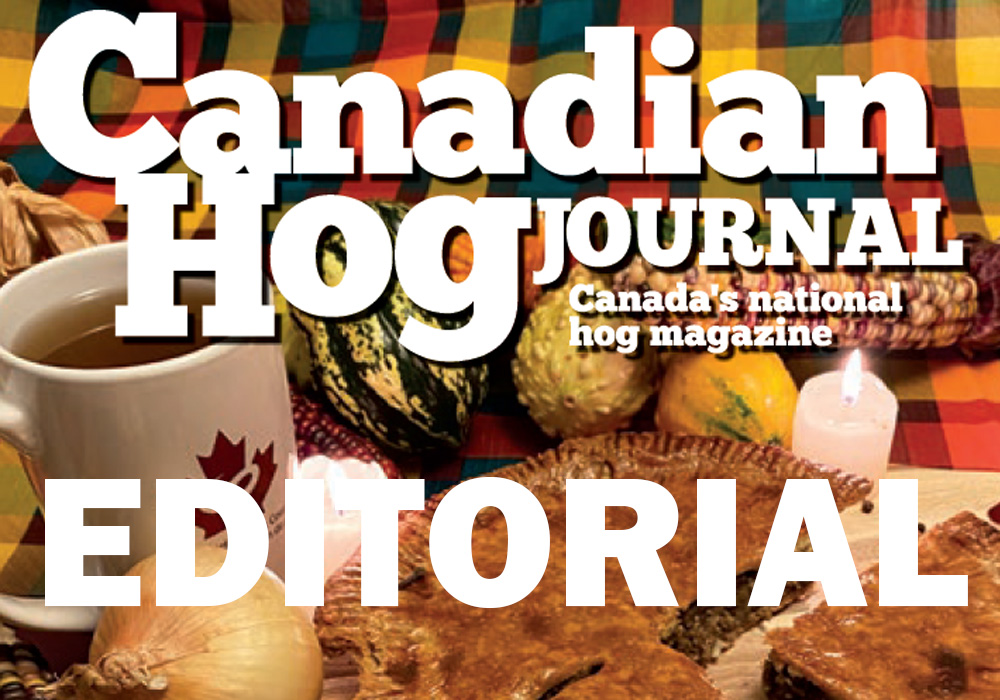
Message from the editor
The Fall 2020 edition of the Canadian Hog Journal is here! I was first introduced as the incoming editor of the Journal in the Fall 2019 edition, so this makes it my official first anniversary.
While every new edition is an exciting accomplishment for me personally and professionally, more importantly, it is an opportunity to advocate for this industry that supports tens of thousands of jobs, millions of Canadians and billions of global consumers.
We should all take time to appreciate the good things in our lives, but I feel compelled to digress a bit. The 2020 calendar year certainly has felt like an eternity for all the wrong reasons, no thanks to where we find ourselves as a sector, and producers are still facing a long-term negative pricing situation. Being so close to this issue myself, from an investigative point-of-view, it can be mentally draining. Still, that feeling pales in comparison to the ongoing stress producers must manage on a daily basis.
It is my sincere hope that all industry representatives, including magazine editors, are doing the right things to help you navigate this storm with as little hardship as possible. That is our goal and duty. Our collective success or failure has wide-reaching implications for many people.
In the Summer 2020 edition, we continued to provide coverage of shared value concerns across the entire Canadian pork supply chain. And while it would appear there are some positive outcomes to certain discussions, lingering issues and adversarial relationships can be difficult to overcome. Drilling down on shared value, this edition considers the balance of marketing power between producers, processors and retailers, and how that has changed over time. Despite the discomfort, producers must keep fighting for fairness.
Processing plant protests continue to be a platform for animal activists, but now, support for farmers and truckers is starting to receive attention, as shown in this edition’s coverage of recent rallies.
On the disease management side, we provide an overview of activities taking place on the national level to combat African Swine Fever (ASF). While value-sharing and other contentious issues can divide stakeholders, ASF represents a universally respected threat, and we all have to be on guard.
On the food side, consider an expert’s opinion on COVID-19’s impact on meat retail. While grocer profits are up, so are consumer prices, thanks to more Canadians eating at home.
Research in this edition covers a study of genetic disease resilience in grow-finish pigs, how science is taking a bite out of feed costs and the cost of sow exercise.
Readers are always encouraged to drop me a line at andrew.heck@albertapork.com. I want to share your views in our ‘Letters to the editor’ section. Dialogue and understanding are the only way we can move forward, and we need a stronger chorus of voices to speak up if we wish to be heard. As it stands, it would seem our messages are getting lost somewhat in a world with so many competing interests, whether those represent ‘priorities’ or not. When push comes to shove, many may soon find out the hard way that food is not only a priority but likely the top one.
Letters to the editor
In reply to “Producer-packer tensions threaten viability” (Summer 2020)
“Why aren’t Canadian pig farmers seeing any benefit from the record-high pork export prices and volumes processors are benefiting from? The prices we receive for our animals are at a decade low. The pricing system is broken and needs to be fixed ASAP, or there will be no pig farmers left in Canada outside of Quebec.” – Mick O’Toole, Neerlandia, Alberta
In reply to “Producer-packer tensions threaten viability” (Summer 2020)
“Western Canadian producers could perhaps benefit from a pricing system like Conestoga has in Ontario, where their producers were being paid more than $2 per kilogram in mid-July, while others across the province were being paid $1.20, which is roughly $0.60 below cost of production. I have also heard about multiple producers sending their financial statements to packers like Sofina to try and get better prices, since the packers are making money like crazy right now.” – Jeremy Van Dorp, Woodstock, Ontario
In reply to “Producer-packer tensions threaten viability” (Summer 2020)
“This really looks like the end of the western Canadian independent producer as a previously viable part of our agricultural output. The circumstances are what make this almost unbelievable – that a commodity with increasing worldwide demand cannot be produced economically because of local pricing structure, rather than logistics, climate or other more obvious variables.
“This is a very western Canadian problem, and it saddens me to see independent producers choosing to downsize or exit the industry. Clearly there must be a space for all viable production. With the loss of one part of the sector, we lose production in the short term and the value of agri-business diversity overall. Not everyone can be, or desires to be, a global megaproducer, but both indeed have merit for different reasons. And there should be room for both, if both can find ways to access fair value in their product.” – Brent Taylor, Drumheller, Alberta




